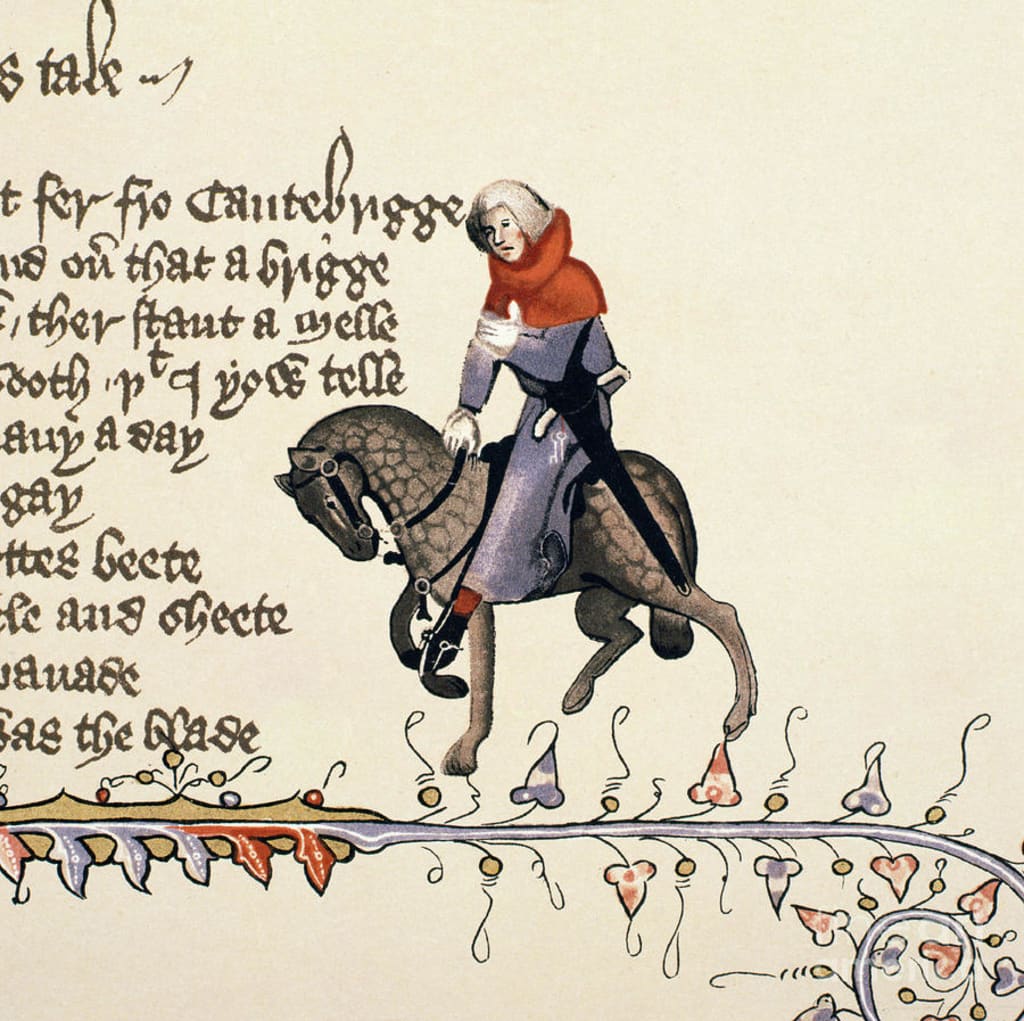The Reeve's Tale, by Geoffrey Chaucer
The Reeve repays the Miller for the latter's insults

The Reeve’s Tale follows immediately after the Miller’s Tale in Chaucer’s Canterbury Tales, and is told as a rejoinder to it. A reeve, in medieval society, was in the pay of the lord of the manor, responsible for seeing that the lord’s crops and animals were looked after. Under the feudal system, the villagers were required to work partly on the lord’s land, or offer a portion of their professional services, for no return other than the lord’s protection and access to his court of justice. The reeve acted as the lord’s enforcer to make sure that this work was done properly, and he was therefore unlikely to be a popular character.
We know that Chaucer’s miller has a “thombe of gold”, meaning that he was adept at cheating his customers, and he would probably have waged a running battle with his local reeve who would doubtless have spent considerable amounts of time trying to prove that the miller was on the fiddle. The reeve of this pilgrimage appears to have fallen out with the miller at quite an early stage; no doubt they saw each other as enemies from the moment they first met.
We know from the General Prologue that the reeve was a carpenter by profession, and that the miller’s tale, about a cuckolded, elderly carpenter, was aimed directly at the reeve, who we also know to be getting on in years. At the end of the miller’s tale, the reeve’s prologue begins with an account of general merriment on the part of the pilgrims, who have all been highly amused by the tale; all, that is, apart from the reeve.
The reeve begins by reflecting on the bitterness of old age. Don’t expect too much merriment from me, he tells them, when you get to my age there’s not much left apart from envy and anger. He cannot therefore let the miller get away with his jibe against an elderly carpenter without getting his own back, and that is precisely what he intends to do.

The Tale
The story concerns a miller called Symkyn, who has a wife who comes from “noble kyn”, a daughter of twenty, and a young child still in its cradle. Symkyn is apparently a typical miller in that he is in the habit of stealing from his customers; it was not difficult for a miller to give less weight in flour than he had received in corn and to take the difference for himself.
The mill is near Cambridge, and one of the miller’s customers is a Cambridge college. The college is suspicious that the miller has cheated them, but they have no way of proving it. Two of the students, John and Aleyn, offer to take some corn to the mill to see if they can get the proof. The students propose to watch the corn go in and the flour come out, but that hardly suits the miller’s purpose. Instead, he sets their horse loose to run off with the local wild mares. Needless to say, the miller steals some of their flour while the students go chasing after the horse.
Eventually the horse is caught and brought back to the mill, but it is now too late for them to go back to town and they ask the miller to put them up for the night, for which they are willing to pay. The miller agrees, gives them a good meal, and then sorts out the sleeping arrangements in the only bedroom that the mill has to offer.
This means that John and Aleyn must share a bed, so that the miller and his wife can be together and the daughter has a bed of her own. The cradle with the baby in it is placed at the foot of the bed containing the miller and his wife; keep an eye on that cradle, it’s the key to all of what happens next!
The miller and his family all sleep soundly, but snore so loudly that the students cannot sleep. Aleyn decides that he will have his wicked way with the daughter; apart from anything else, it will count as payment for the flour that he is sure has been stolen by the miller. John warns him not to wake the miller.
Aleyn loses no time in doing what he said he would, which leaves John lying there in a state of frustration. However, he then puts a plan of his own into play. He gets up in the dark, finds the cradle at the foot of the bed shared by the miller and his wife, and moves it to the foot of his own bed. When the miller’s wife gets up to obey a call of nature, she consequently gets into the wrong bed on her return. (Hm! Perhaps it was a good job that it was not the miller who got up in the night!)
Aleyn wakes up and decides to go back to his own bed, having first been told by the grateful miller’s daughter where he can find a loaf of bread that the miller had baked using the stolen flour. Aleyn comes across the cradle and stops short of getting into what he assumes must be the miller’s bed; instead, he gets into what really is the miller’s bed and whispers into the miller’s ear, thinking it to be John’s of course, all the details of what he has just done to the miller’s daughter.
Events now move with startling speed. The miller jumps up and smashes Aleyn’s nose, which bleeds profusely. The two fight on the floor, until the miller falls backwards and lands on top of his wife, who is of course in bed with John, but does not know this. She therefore assumes that it must be the two students who are fighting in the dark.
John jumps up and starts feeling his way along the wall for some sort of weapon. The wife does the same, and is the first to find a big stick. As a shaft of moonlight allows her to see something white on the floor, she thinks it must be Alleyn’s nightcap and aims a blow at it. It is actually the miller’s bald head that she has seen, and she manages to knock down her own husband, after which the two students add a few more blows.
The students then dress hurriedly and make their escape, taking their flour and the baked loaf with them. The reeve ends his tale by pointing out that the miller has been soundly and justly punished for his misdeeds, and also that he, the reeve, has paid the pilgrim miller back for his earlier story at the reeve’s expense.
Discussion
This story is similar to the Miller’s Tale in being in the “fabliau” tradition of a short story told by and for ordinary working people. In these tales it was the plot that counted for far more than the characterizations and descriptions. Many of these stories were realistic in nature, generally humorous, and often indecent. Chaucer has retained these essential points, although adding more description and relying on the element of poetic justice.
However, there is more humour in the miller’s offering than the reeve’s. At the latter’s conclusion it is only the cook who is heard to laugh, and to offer another tale in similar vein, whereas the whole company found the miller’s tale to be to their liking. There was no real violence in the miller’s story, apart from the application of a red-hot piece of metal to a bare buttock, but blood is spilled in the denouement of the reeve’s tale, and the students continue to lay into the miller even after he has been knocked to the ground.
Likewise, the sex in the miller’s tale is consensual, and it is what the two plotters want to happen. In the reeve’s tale, two rapes take place, in effect. There is certainly no foreplay involved!
The reeve’s tale has all the makings of a rollicking bedroom farce, of the type that became extremely popular in 19th century French and 20th century British theatre. It could have been an enjoyable comedy of errors, with people getting into the wrong beds and all the consequences of so doing. But the reeve spoils it all by being so unpleasant. His aim is, after all, to spite the miller who has insulted him, rather than to entertain his fellow pilgrims. In this, he has lived up to the promise given before he started his tale.
What this all boils down to is the theme that runs throughout the whole of the Canterbury Tales, namely that the main characters are not within the tales but outside them. We learn a great deal from the pilgrims through the stories they tell, which is also why Chaucer gives us such interplay between the characters before and after (and sometimes even during) the telling of their tales. It is therefore a mistake to read the tales outside their context, and part of that context is the section of the General Prologue devoted to each of the tellers (or nearly all). In this instance, the miller is a likeable character who tells a bawdy but good-humoured tale about characters we can get to like. The reeve is an unpleasant man who cannot tell a pleasant tale.
About the Creator
John Welford
I am a retired librarian, having spent most of my career in academic and industrial libraries.
I write on a number of subjects and also write stories as a member of the "Hinckley Scribblers".






Comments
There are no comments for this story
Be the first to respond and start the conversation.